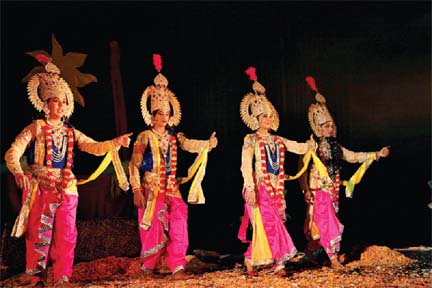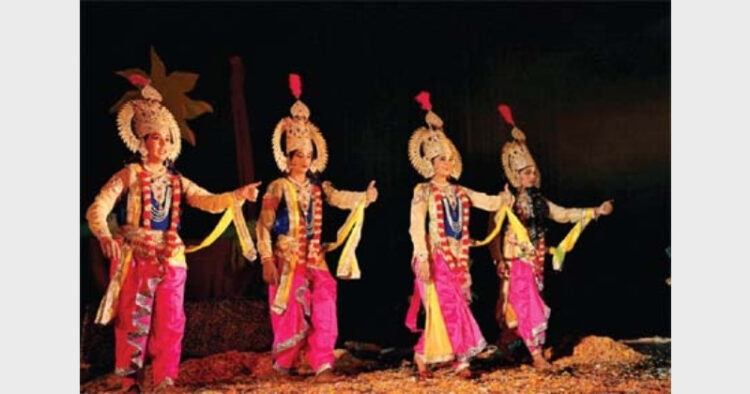 Ramayana and Ram have served as a bridge between Bharat and the world for centuries. This diplomatic and cultural connect was resurrected through the World Ramayana Convention
Ramayana and Ram have served as a bridge between Bharat and the world for centuries. This diplomatic and cultural connect was resurrected through the World Ramayana Convention
Prashant Bajpai in Jabalpur
The World Ramayana Convention organised at Jabalpur from December 21 to 23 was attended by 250 delegates from many countries of the world. A toatl of 55 scholars and experts presented their views. Many cultural performances also took place.
Speaking as chief guest and keynote speaker at the opening ceremony RSS Sahsarkaryavah Dr Krishna Gopal said, “Every dialogue of Ramcharitmanas provides us a direction. The legend of Shri Ram has many landing places. The dialogue of Ram with Sita, with Kaushalya, Kaikeyi, Bharat, Vibheeshan, Nishad and Kevat, etc are the piers of knowledge. When Vibheeshan asks Ram how he would defeat Ravana without armour, chariot and footwear, Ram says, “O Friend! The chariot of victory has two wheels — courage and bravery. Truth and character are its flags. Strength, conscience, patience and wellness of others are its four horses. Forgiveness, grace and equality with all are its halter. God’s praise is the charioteer. Austerity is the shield. Satisfaction is the weapon. Benevolence is its blade. Wisdom is the bow. The stable mind is arrow quiver. Yama and Niyam are its arrows. Respect to teacher and wise men are the armour. No one can defeat someone who possesses such a chariot and means.”
Noted Vedic scholar Stephen Knapp said, “The Ramayana tells us how the leadership should be like. The example of Ram Rajya tells us that true leadership provides direction to the society and takes the society towards welfare. Such a ruler has a wider impact. Ramayan also tells us how a ruler has to mitigate any type of injustice, crime and lawlessness immediately. The examples of both Ram and Ravana are in front of the world as to how the leadership takes its subjects towards destruction or welfare. This is why Ramayana can never be obsolete. It gives us practical education.”
Major General GD Bakshi made an impressive presentation on ancient Bharatiya military science. Indrani Ramprasad of Ayodhya Research Institute spoke about the Caribbean Ramlilas and said the art form reached Caribbean between 1838 and 1917 from Bharat. It followes the same form as is in our cities and towns.
The group of scholars coming from Thailand drew everyone’s attention. Nongluksan Thepsavsdi, Director of the India Study Centre and several other Departments of the Thammsat University, Bangkok, said, “We in Thailand call the Ramayana as ‘Ramkin’. Ramayana is considered there as a cultural literature, which gives direction to society. Ramlila is watched by every age group. Khon Ramlila is considered to be very superior and Thailand’s royal family organises it for its royal guests. Khon is actually a dance drama. Thus, Ramayana has dominated the literature and the arts of Thailand. Nang Yai (performances through the shadow images on the screen), Nang Talung and puppet dance are some other arts related to Ramayana. Songs, music and drapery related to these performances are made in a highly artistic manner. Movies, paintings and sculptures based on scenes from Ramayana are also much in vogue. Besides Thailand, Ramayana has deeply influenced the culture, art and literature of many Asian countries like Cambodia, Burma and others.”
Ramdas Lamb, Professor at the University of California, said Ramcharitmanas is the most-read book by the Hindus spread throughout the world because Goswami Tulsidas has composed it in an easy language and made acceptable to the common people by providing easy interpretation of
profound subjects. That is why it is believed at some places that Tulsidas was an incarnation of Maharishi Valmiki who did a favour to the humanity by presenting the Ram’s story in a timely manner. Yet, there are evident fundamental differences between the story of Ram as told by Valmiki and Tulsidas. These differences exist both at the social and philosophical level. Ramcharitmanas finds similarity more with the Adhyatma Ramayana composed in medieval times. In fact, Adhyatma Ramayana and Ramcharitmanas are the manifestations of the Bhakti Movement that spread in the society with the flow of time. The Bhakti movement moved the society for half a century.”
Michael Sternfeld, who came from Iowa, USA, shed light on the deeper and broader sense of religion. He said, “Ram’s story makes us travel to the micro levels of the religion. When we tread by listening to Ram’s life, our outlook becomes wider with each step by assimilating the adaptability and broadness of the religion. Religion (Dharma) does not mean merely following one’s duty, as is understood in the West. The Dharma holds all creation and continuously takes us to the higher dimensions of consciousness. As much we look towards the Dharma, we get connected to the natural course of the universe in the same measure. The Dharma has many layers, which are actually the more and more feeling of the nature and consciousness. Our livelihood is one of the levels of religion. We have our personal requirements and responsibilities. Then a person”s following his or her Dharma gets connected to the family, society, nation and humanity. Every particle of the universe comes in the realm of religion. The Dharma of a star is to spread light and life in the world. The Dharma of the universe is to move forward toward the infinite expanse of the sky.”
Bharatiya philosophy is attracting many of the scientists towards it for almost a century. The statements of prominent scientists, including Einstein, are quite known. Professor David Scharf, working on the Quantum Field Theory and other dimensions of physics for decades, said, “Though the legend of the Ramayana has been told in worldly fashion where we see incidents like preparations for Ram’s coronation by King Dasharatha, Ram going to the exile, Sita’s abduction, Ram’s invasion of Lanka, killing of Ravana and the Rama, Sita and Lakshmana returning to Ayodhya with the monkey warriors, etc., on the other hand, this timeless story is seen as the one describing the fundamental philosophy of the inner world. Only those whose consciousness is highly developed can understand its essence. This eternal relevance is amazing. This eternity, which we call ‘Angel Time’, tells us that the world that we think as the real and the condition that we feel as waking state is really extremely limited born out of the incomplete understanding. We need deeper and broader understanding that can see by differentiating between common imagination and imagining power. We need a deeper sight to be more waking than our waking state (awake) and to look beyond our current understanding that can take us to the depths of this theory, that this world (or public) is only a link between a series of several worlds, most of which are more subtle than the present state of our consciousness (waking state). If these worlds are real, then the physics also needs to develop its understanding even more so that the internal interaction, mutual relations and the worldly contradictions of these dimensions can be understood. Many new discoveries in advanced physics are bringing the temporal contradictions to the fore which can help understand the difference between the real and unreal.”
Many delegates attending the Convention believed that their desire for the welfare of the world drawn to Bharat. Geoffrey Armstrong, founder of the Vedic Science and Art Academy, Vancouver, Canada is known now as the Kaveendra Rishi. He says, “I have adopted Hinduism to save the earth and humanity. Addressing the Convention, he said, “The power becomes demonic without the Dharma. Modern science is turning the humans evil knowingly or unknowingly because of which the world is moving towards destruction. I want to emphasise that we are busy in turning the world in a massive Lanka which is governed by many Ravanas. We need to wage a virtuous (sattwik) war against this. Today food is becoming toxic; indiscriminate technology, lethal weapons, abuse of media – all these are pushing the earth towards a huge danger. The war against this Ravana needs to be fought with the weapons of education and economics and Bharat is to lead the world in this virtuous war.”
Dr Usha Devi, a member of Hindi Education Association, South Africa, said, “The legend of Ram entered South Africa one and half century ago through the bhajans and Manas Path of the Bharatiya labourers and has today reached to the grand Ram Temple travelling through the research papers, seminars of the universities and various farms of art media.”
Manoj Srivastava, Chief Secretary, Department of Culture, Madhya Pradesh shed light on some of the misconceptions about the legend of Ram. He said based on the changes in style, it can be said that Uttarkand was not part of the original story but was inserted later. Similarly, the chaupai in the Ramcharitmanas “drums, uneducated, Shudra, cattle and women are fit only for thrashing” is often misquoted. The word Tadna means looking after in Awadhi language.
Dr Akhilesh Gumashta, convener of the Convention, said in his presentation, “Goswami Tulsidas has used the word Krupal (one who blesses) for both Ram and Buddha in the Vinay Patrika. He has expressed his faith in Buddha by saying Vande Buddha Krupal.” Many Sadhus and saints also came to the Convention. In his address, Swami Rajeshwaranand threw light on the spiritual side of Ram’s story.
Swami Satyamitranand Giri, patron of the World Ramayana Convention, said in his message, “Ram’s story is a specific guide and saviour shelter for the humanity. Bhagwan Ram is the standard and life-person of Bharat. Most countries of the world not only are familiar with his but also taking inspiration from him for the protection of the life values.”
The Convention was organised to mark the Golden Jubilee year of the Gadha Ramlila Samiti by Brahmarshi Mission Samiti in association with the Indian Council for Cultural Relations, Department of Foreign Relations, Government of India, Indira Gandhi National Centre for the Arts and the World Association for Vedic Studies, Texas, USA. The Indo-Thai Ramayana Forum was also established on this occasion by the Chulalongkorn University and Rani Durgavati University which will continue the academic exchanges in future also. A grand Ramayana Exhibition was organised coinciding with the Convention by IGNCA. Many artistic performances took place on the Ramayana that included many traditional dances including Kathak. Bhajan singer Osman Meer performed the Ram bhajans. The citizens of Sanskardhani thronged to the venue of the programme for three days.
Michael Sternfeld, returning to US after the Convention, was overwhelmed. He said, “It was much more than expected. I had expected an academic Convention. But this was much more. It was an auspicious work that included cultural and social presentations and partnerships, encouragement to the
artistic performances besides academic aspects. It was also a melange of Ram devotees too.” The convention started with Vishnu Sahasranam and concluded with the Shabad Kirtan. n














Comments